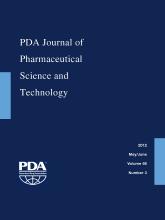Abstract
This paper presents a practical way in which current approaches to quality risk management (QRM) may be improved, such that they better support qualification, validation programs, and change control proposals at manufacturing sites. The paper is focused on the treatment of good manufacturing practice (GMP) controls during QRM exercises. It specifically addresses why it is important to evaluate and classify such controls in terms of how they affect the severity, probability of occurrence, and detection ratings that may be assigned to potential failure modes or negative events. It also presents a QRM process that is designed to directly link the outputs of risk assessments and risk control activities with qualification and validation protocols in the GMP environment.
LAY ABSTRACT: This paper concerns the need for improvement in the use of risk-based principles and tools when working to ensure that the manufacturing processes used to produce medicines, and their related equipment, are appropriate. Manufacturing processes need to be validated (or proven) to demonstrate that they can produce a medicine of the required quality. The items of equipment used in such processes need to be qualified, in order to prove that they are fit for their intended use. Quality risk management (QRM) tools can be used to support such qualification and validation activities, but their use should be science-based and subject to as little subjectivity and uncertainty as possible.
When changes are proposed to manufacturing processes, equipment, or related activities, they also need careful evaluation to ensure that any risks present are managed effectively.
This paper presents a practical approach to how QRM may be improved so that it better supports qualification, validation programs, and change control proposals in a more scientific way. This improved approach is based on the treatment of what are called good manufacturing process (GMP) controls during those QRM exercises. A GMP control can be considered to be any control that is put in place to assure product quality and regulatory compliance. This improved approach is also based on how the detectability of risks is assessed. This is important because when producing medicines, it is not always good practice to place a high reliance upon detection-type controls in the absence of an adequate level of assurance in the manufacturing process that leads to the finished medicine.
- Quality risk management
- Qualification
- Validation
- Change control
- Good manufacturing practice
- Controls
- Subjectivity
- Uncertainty
- © PDA, Inc. 2012
PDA members receive access to all articles published in the current year and previous volume year. Institutional subscribers received access to all content. Log in below to receive access to this article if you are either of these.
If you are neither or you are a PDA member trying to access an article outside of your membership license, then you must purchase access to this article (below). If you do not have a username or password for JPST, you will be required to create an account prior to purchasing.
Full issue PDFs are for PDA members only.
Note to pda.org users
The PDA and PDA bookstore websites (www.pda.org and www.pda.org/bookstore) are separate websites from the PDA JPST website. When you first join PDA, your initial UserID and Password are sent to HighWirePress to create your PDA JPST account. Subsequent UserrID and Password changes required at the PDA websites will not pass on to PDA JPST and vice versa. If you forget your PDA JPST UserID and/or Password, you can request help to retrieve UserID and reset Password below.






